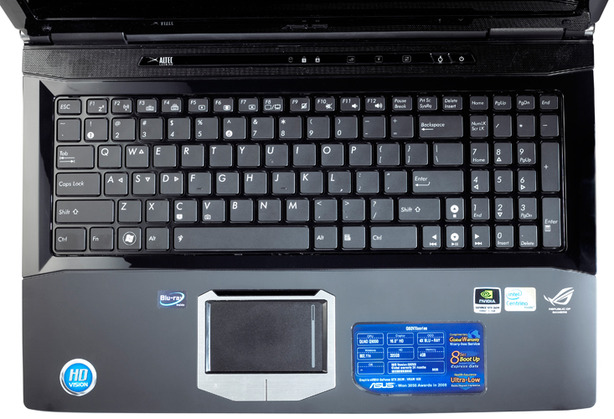
Features & Build Quality
Under the fluorescent lights of the lab, and surrounded by the usual piles of PC kit, the G60Vx’s looks seem more confident than they did in the Lambo salesroom. The white lid is the only weak part of the styling; its slight pearlescent sheen is a touch too gaudy instead of pure and minimalist, especially when you take into account the grey gearwork design surrounding the RoG badge.Still, the G60Vx is far from the total travesty of taste some past gaming laptops have been. The badge lights up, and as it’s the only form of external illumination it looks quite smart. Open the G60Vx up and inside it’s a very attractive machine (although you do need to pull off three hundred odd boastful stickers wittering on about HD-this and Centrino-that).
The keyboard – chiclet style, where all the keys are surrounded by their own border of space – is set on black shiny plastic, while the wrist-rest is a dark grey, and slightly rubberised for a comfy feel. The keys are illuminated, too. The keyboard doesn't quite extend to the edges of the chassis, but you do get a number pad, and decent sized shift, backspace and enter keys.

The G60Vx's keyboard is one of the highlights of the machine
It’s solid, too, without much flex, and a nice degree of travel for the keys, making it one of the best things about the G60Vx. The trackpad looks great too, with the buttons flowing into a slice of aluminum surrounding the trackpad. On our model they were slightly on the tough side to press.
The wrist-rest area doesn’t get too hot, which is surprising when you consider the amount of hot air being pushed out of the main vent on the G60Vx’s left-hand side: even when the machine is sat in Windows just running Word for me to type this review there's a steady stream of warm air flowing out. This might be because the machine only has one vent.
The hardware producing the heat isn’t quite as scintillating as the 552bhp V10 in the Lamborghini, but it still looks good for the money, and at £1,347, it's not outrageously priced for a gaming laptop. Asus has based its system on a Core 2 Duo P8700, a dual-core chip clocked at 2.53GHz. This is built, as you’d expect on Intel’s 45nm process with a 1,066MHz FSB and 3MB of L2 cache. There’s 4GB of DDR3 memory, and in our test sample, a 320GB 7,200rpm Seagate hard disk (the retail version features two, though not running in RAID).
Asus includes an optical drive that can play Blu-Ray discs, as well as write DVD+R/RW and -Rs at 8x and DVD-RWs at 6x speeds. There’s a HDMI and D-SUB outputs (but no DVI), along with four USB 2 ports and an eSATA connection. Asus loses points for supplying the machine with 32-bit Vista Ultimate; the fact it’s 32-bit means you won’t get access to all 4GB of memoy, and Ultimate is needlessly expensive, adding very little of value over the Home Premium edition.

MSI MPG Velox 100R Chassis Review
October 14 2021 | 15:04








Want to comment? Please log in.